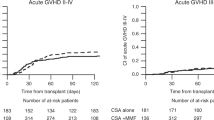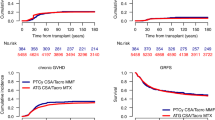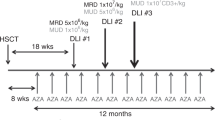Summary:
In an attempt to decrease toxicity in high-risk patients undergoing unrelated donor hematopoietic stem cell transplantation (URD HSCT), we tested a combination of cyclosporine (CSP) and mycophenolate mofetil (MMF) as graft-versus-host disease (GVHD) prophylaxis with the reduced-intensity conditioning regimen fludarabine/melphalan (Flu/Mel). A total of 22 adult patients with advanced myeloid (n=15) and lymphoid (n=7) malignancies were treated. All patients received Flu 25 mg/m2 for 5 days and Mel 140 mg/m2, with CSP 3 mg/kg daily and MMF 15 mg/kg three times a day. The median age was 49 years (range 18–66). Durable engraftment was seen in all but one patient with myelofibrosis. The 1-year nonrelapse mortality was 32%, 27% from GVHD. The cumulative incidence of acute GVHD grade 2–4 and 3–4 was 63 and 41%, respectively. With a median follow-up of 18 months, the disease-free survival (DFS) and overall survival (OS) are 55 and 59%, respectively. For patients with AML and MDS (n=14), the DFS and OS is 71%. For patients undergoing a second transplant (n=14), the DFS and OS is 57%. In conclusion, this regimen is associated with acceptable toxicity but high rates of GVHD in high-risk patients undergoing URD HSCT. Encouraging disease control for patients with advanced myeloid malignancies was observed.
This is a preview of subscription content, access via your institution
Access options
Subscribe to this journal
Receive 12 print issues and online access
$259.00 per year
only $21.58 per issue
Buy this article
- Purchase on Springer Link
- Instant access to full article PDF
Prices may be subject to local taxes which are calculated during checkout



Similar content being viewed by others
References
Report on state of the art in blood and marrow transplantation. The IBMTR/ABMTR summary slides with guide, 2002 available online at http://www.ibmtr.org/infoserv/info>sums.html (accessed May 2, 2003).
Radich JP, Sanders JE, Buckner CD et al. Second allogeneic marrow transplantation for patients with recurrent leukemia after initial transplant with total-body irradiation-containing regimens. J Clin Oncol 1993; 11: 304–313.
Giralt S, Thall PF, Khouri I et al. Melphalan and purine analog-containing preparative regimens: reduced-intensity conditioning for patients with hematologic malignancies undergoing allogeneic progenitor cell transplantation. Blood 2001; 97: 631–637.
Storb R, Yu C, Barnett T et al. Stable mixed hematopoietic chimerism in dog leukocyte antigen-identical littermate dogs given lymph node irradiation before and pharmacologic immunosuppression after marrow transplantation. Blood 1999; 94: 1131–1136.
McSweeney PA, Niederwieser D, Shizuru JA et al. Hematopoietic cell transplantation in older patients with hematologic malignancies: replacing high-dose cytotoxic therapy with graft-versus-tumor effects. Blood 2001; 97: 3390–3400.
Niederwieser D, Maris M, Shizuru JA et al. Low-dose total body irradiation (TBI) and fludarabine followed by hematopoietic cell transplantation (HCT) from HLA-matched or mismatched unrelated donors and postgrafting immunosuppression with cyclosporine and mycophenolate mofetil (MMF) can induce durable complete chimerism and sustained remissions in patients with hematological diseases. Blood 2003; 101: 1620–1629.
Schaffer M, Olerup O . HLA-AB typing by polymerase-chain reaction with sequence-specific primers: more accurate, less errors, and increased resolution compared to serological typing. Tissue Antigens 2001; 58: 299–307.
Przepiorka D, Weisdorf D, Martin P et al. 1994 Consensus conference on acute GVHD grading. Bone Marrow Transplant 1995; 15: 825–828.
Shulman HM . Graft-versus-host disease. Surv Synth Pathol Res 1984; 3: 233–234.
Bearman SI, Appelbaum FR, Buckner CD et al. Regimen-related toxicity in patients undergoing bone marrow transplantation. J Clin Oncol 1988; 6: 1562–1568.
Barrett AJ, Malkovska V . Graft-versus-leukaemia: understanding and using the alloimmune response to treat haematological malignancies. Br J Haematol 1996; 93: 754–761.
Goulmy E . Human minor histocompatibility antigens. Curr Opin Immunol 1996; 8: 75–81.
Mutis T, Blokland E, Kester M et al. Generation of minor histocompatibility antigen HA-1-specific cytotoxic T cells restricted by nonself HLA molecules: a potential strategy to treat relapsed leukemia after HLA-mismatched stem cell transplantation. Blood 2002; 100: 547–552.
Sievers E, Larson R, Estey E et al. Final report of prolonged disease-free survival with acute myeloid leukemia in first relapse treated with Gemtuzumab Ozogamicin followed by hematopoietic stem cell transplantation (abstract). Blood 2002; 100: 327a.
Devine SM, Sanborn R, Jessop E et al. Fludarabine and melphalan-based conditioning for patients with advanced hematological malignancies relapsing after a previous hematopoietic stem cell transplant. Bone Marrow Transplant 2001; 28: 557–562.
Sullivan KM, Agura E, Anasetti C et al. Chronic graft-versus-host disease and other late complications of bone marrow transplantation. Semin Hematol 1991; 28: 250–259.
Shimoni A, Giralt S, Khouri I, Champlin R . Allogeneic hematopoietic transplantation for acute and chronic myeloid leukemia: non-myeloablative preparative regimens and induction of the graft-versus-leukemia effect. Curr Oncol Rep 2000; 2: 132–139.
Molina A, Arber D, Murata-Collins LJ et al. Clinical, cytogenetic and molecular remissions after hematopoietic stem cell transplantation (HSCT) for refractory Sezary syndrome and tumor-stage mycosis fungoides (abstract). Blood 2001; 98: 409a.
Khouri IF, Keating M, Korbling M et al. Transplant-lite: induction of graft-versus-malignancy using fludarabine-based nonablative chemotherapy and allogeneic blood progenitor-cell transplantation as treatment for lymphoid malignancies. J Clin Oncol 1998; 16: 2817–2824.
Anderlini P, Giralt S, Andersson B et al. Allogeneic stem cell transplantation with fludarabine-based, less intensive conditioning regimens as adoptive immunotherapy in advanced Hodgkin's disease. Bone Marrow Transplant 2000; 26: 615–620.
Giralt S, Aleman A, Anagnostopoulos A et al. Fludarabine/melphalan conditioning for allogeneic transplantation in patients with multiple myeloma. Bone Marrow Transplant 2002; 30: 367–373.
Chiang KY, Weisdorf DJ, Davies SM et al. Outcome of second bone marrow transplantation following a uniform conditioning regimen as therapy for malignant relapse. Bone Marrow Transplant 1996; 17: 39–42.
Barrett AJ, Locatelli F, Treleaven JG et al. Second transplants for leukaemic relapse after bone marrow transplantation: high early mortality but favourable effect of chronic GVHD on continued remission. A report by the EBMT Leukaemia Working Party. Br J Haematol 1991; 79: 567–574.
Acknowledgements
We acknowledge Diana Garcia for her assistance in manuscript preparation. We also thank other people who contributed to this study including Thomas Morrison, Allison Sano, Kathy Patane, and Popsie Gaytan.
Author information
Authors and Affiliations
Corresponding author
Rights and permissions
About this article
Cite this article
Rodriguez, R., Parker, P., Nademanee, A. et al. Cyclosporine and mycophenolate mofetil prophylaxis with fludarabine and melphalan conditioning for unrelated donor transplantation: a prospective study of 22 patients with hematologic malignancies. Bone Marrow Transplant 33, 1123–1129 (2004). https://doi.org/10.1038/sj.bmt.1704493
Received:
Accepted:
Published:
Issue Date:
DOI: https://doi.org/10.1038/sj.bmt.1704493
Keywords
This article is cited by
-
Pharmacokinetics of intravenous mycophenolate mofetil in allogeneic hematopoietic stem cell-transplanted Japanese patients
Cancer Chemotherapy and Pharmacology (2018)
-
Use of mycophenolate mofetil and a calcineurin inhibitor in allogeneic hematopoietic stem-cell transplantation from HLA-matched siblings or unrelated volunteer donors: Japanese multicenter phase II trials
International Journal of Hematology (2017)
-
Mycophenolate mofetil: fully utilizing its benefits for GvHD prophylaxis
International Journal of Hematology (2012)
-
Reduced-intensity conditioning by fludarabine/busulfan without additional irradiation or T-cell depletion leads to low non-relapse mortality in unrelated bone marrow transplantation
International Journal of Hematology (2011)
-
Thymoglobulin, CYA and mycophenolate mofetil as GVHD prophylaxis for reduced-intensity unrelated donor hematopoietic cell transplantation: beneficial effect seen on chronic GVHD
Bone Marrow Transplantation (2010)



